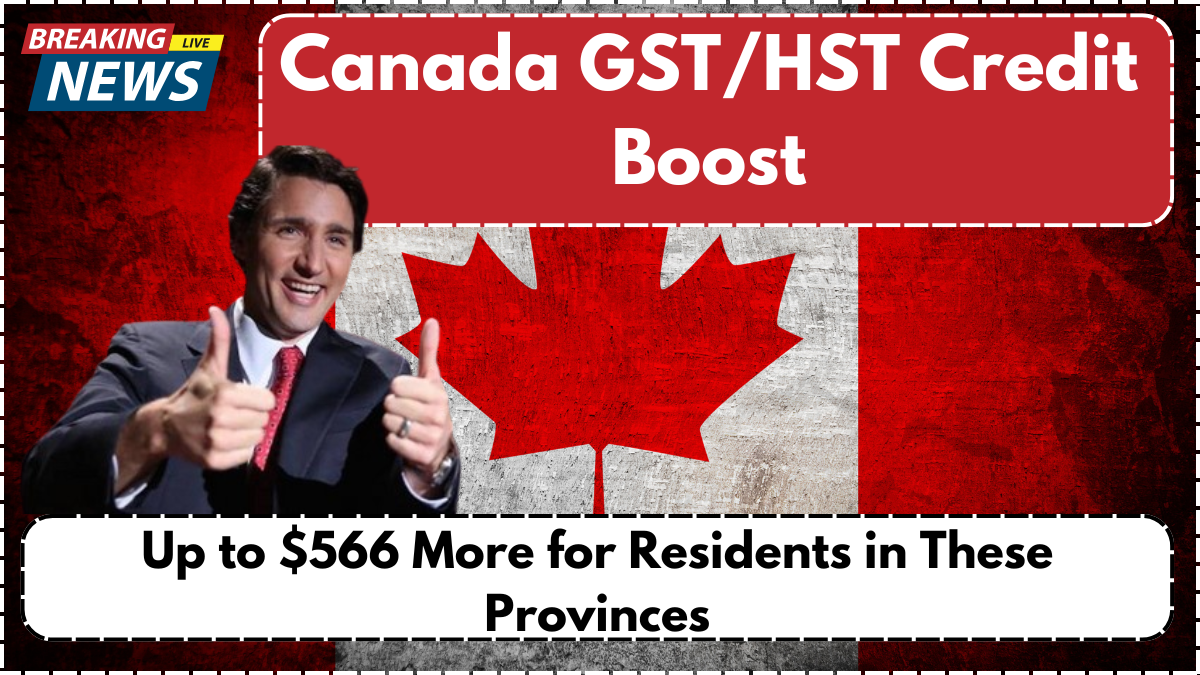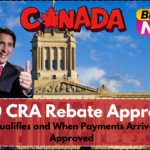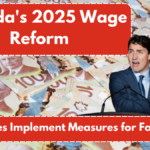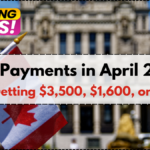The Canada Revenue Agency (CRA) continues to issue GST/HST Credit payments each quarter to help low- and moderate-income Canadians manage the financial burden of sales taxes. While most people are familiar with the federal portion, fewer know about the valuable provincial and territorial top-ups that can significantly increase quarterly payments.
These additional credits are automatically included with your federal GST/HST Credit. You don’t need to apply separately. Depending on your province or territory, these enhancements can boost your benefit by as much as $566.75 every three months.
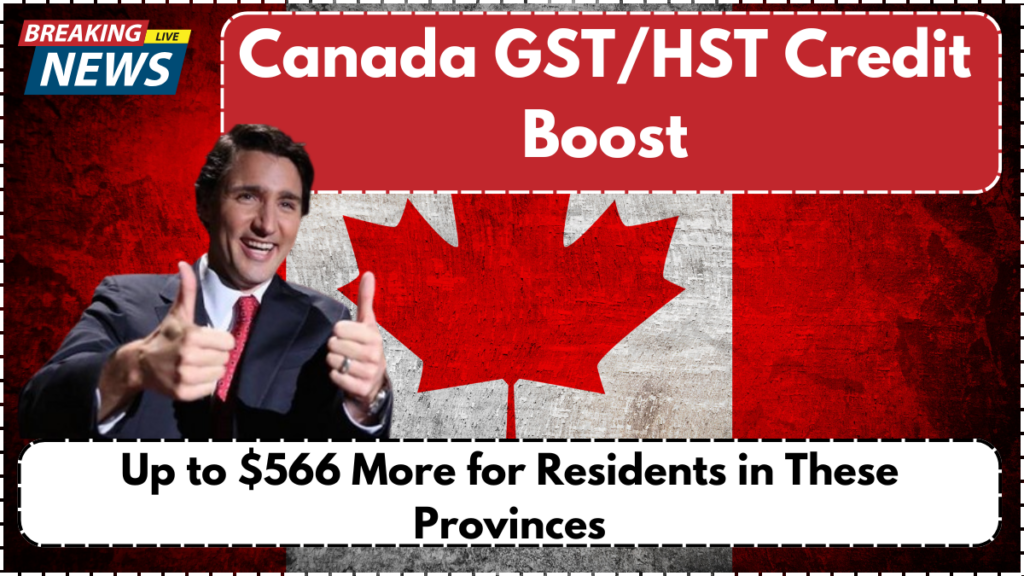
What Are GST/HST Top-Ups?
Provincial and territorial top-ups are extra payments layered onto your GST/HST Credit. These are meant to address local cost-of-living challenges, carbon tax impacts, or to support specific demographics such as seniors, low-income families, or individuals with disabilities.
Who Gets the Extra Payments in April 2025?
As of April 2025, residents of nine provinces and territories will receive additional top-up amounts with their regular GST/HST Credit. These are:
- Newfoundland and Labrador
- British Columbia
- Saskatchewan
- New Brunswick
- Nova Scotia
- Prince Edward Island
- Nunavut
- Northwest Territories
- Yukon
Breakdown of Maximum Top-Ups by Region (Family of Four)
| Province/Territory | Maximum Extra (Quarterly) | Ending in 2025? |
|---|---|---|
| Newfoundland & Labrador | $566.75 | No |
| Saskatchewan | $277.50 | No |
| Northwest Territories | $502.00 | Yes |
| British Columbia | $252.00 | Yes |
| Yukon (rural) | $372.00 | Yes |
| Nova Scotia | $93.75 | No |
| New Brunswick | $200.00 | No |
| Prince Edward Island | $55.00 | No |
| Nunavut | $100.00 | Yes |
Detailed Provincial and Territorial Benefits
Newfoundland and Labrador
This province offers three key credits: the Newfoundland and Labrador Income Supplement, a Disability Amount, and a Seniors’ Benefit. Combined, eligible residents can receive up to $566.75 per quarter:
- $130 for an individual
- $17.25 for a spouse or common-law partner
- $57.75 per dependent child
- $57.75 per eligible person with a disability
- $379 for qualifying seniors
These payments are designed to support families, seniors, and persons with disabilities, and are calculated based on your tax return.
British Columbia
April 2025 marks the final payment of the BC Climate Action Tax Credit, introduced to offset the carbon tax. This will be discontinued in future quarters due to policy shifts.
- $126 per individual
- $63 for a spouse or first child in a single-parent household
- $31.50 per additional child
Families earning over $41,071 (individuals) or $57,288 (families) will see a reduced benefit.
Northwest Territories
Residents here will also receive their last carbon tax rebate this quarter. Payments vary by zone:
- Zone C residents: $117.50 per adult, $133.50 per child
- Maximum for family of four: $502
Yukon
Yukon’s carbon rebate is based on residency:
- Whitehorse residents: $77.50 per person
- Rural residents: $93 per person
- Family of four in rural areas: Up to $372
These credits are universal and not income-tested.
Nova Scotia
The Affordable Living Tax Credit offers:
- $63.75 per eligible individual or couple
- $15 per child
Family of four maximum: $93.75 per quarter.
Prince Edward Island
Residents receive the PEI Sales Tax Credit:
- $41.25 per individual
- $13.75 per spouse or dependent
- Maximum: $55 per quarter
Saskatchewan
The Saskatchewan Low-Income Tax Credit provides:
- $99.50 per adult
- $39.25 per child (up to two children)
- Maximum: $277.50 for a family of four
New Brunswick
The NB Harmonized Sales Tax Credit offers:
- $75 for an individual
- $75 for a spouse or first child
- $25 for each additional child
- Family of four: $200 maximum
Nunavut
Final carbon tax payment in April 2025:
- $25 per household member
- Family of four: $100
Provinces Without CRA-Delivered Top-Ups
Some provinces do not use the CRA to administer their GST/HST-related supports:
- Ontario: Offers the Ontario Trillium Benefit with energy and tax credits, paid monthly.
- Alberta: Provides occasional relief payments for families and seniors.
- Manitoba: Offers targeted support during specific periods.
- Quebec: Handles all credits through its own tax system.
What You Need to Know for April 2025
- No application required: These credits are automatic once you file your taxes.
- Eligibility may vary: Even if you’re not eligible for the federal GST/HST Credit, you might still qualify for a provincial top-up.
- Programs ending: Some carbon-related rebates will end after this payment cycle.
- File your taxes: Make sure your return is up to date to receive full benefits.
Conclusion
April 2025 brings notable changes to the GST/HST Credit system, with several provincial top-ups ending, especially those linked to carbon pricing. However, others remain in place, providing crucial support to Canadians facing high living expenses. Filing your tax return accurately and on time remains the best way to ensure you receive every dollar you’re entitled to.
FAQ
What is the GST/HST Credit?
The GST/HST Credit is a quarterly tax-free payment from the CRA meant to help lower-income Canadians offset sales tax costs.
How do I receive the provincial top-ups?
These are automatically added to your federal GST/HST Credit. You don’t need to apply separately.
Will the top-up amounts change later in 2025?
Some will end after April 2025, especially carbon-related rebates. Others will remain based on provincial policies.
What if I moved to another province recently?
Your benefit amount is calculated based on your province of residence as listed on your tax return.
Can I still receive a top-up if I don’t qualify for the GST/HST Credit?
Yes, in some cases. Certain provincial programs have different eligibility rules and may still apply.
For More Information Click Here
Pari is a passionate writer known for captivating stories that blend imagination and reality. Inspired by travel, history, and everyday moments, Pari crafts narratives that resonate deeply with readers.
